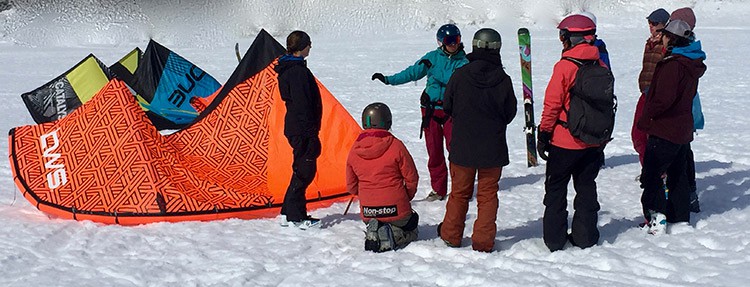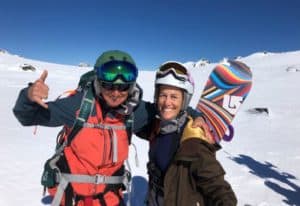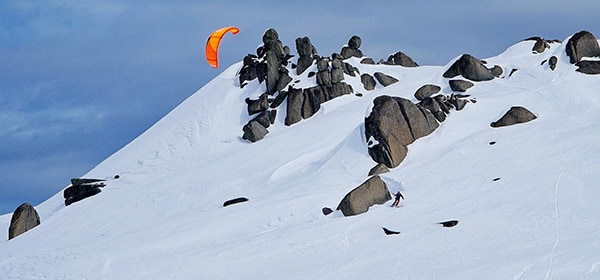Want to learn to Snowkite?
If you already know how to kitesurf on the water or just want to kite on the snow, it’s not hard to learn with the right equipment and knowledge from professionals to guide you to stay safe and have fun.
Here are our top 5 things you need before you hit the mountains to escape the crowds and carve your own tracks.
Make sure your skiing skills are up to scratch
 It doesn’t matter if you are a skier or snowboarder, but you need to have an intermediate to advanced level of proficiently on the snow. It’s easy to hike out to the back country with adequate fitness but can you get back down the mountain over the flats, steep descents and all this with your packs on your back too?
It doesn’t matter if you are a skier or snowboarder, but you need to have an intermediate to advanced level of proficiently on the snow. It’s easy to hike out to the back country with adequate fitness but can you get back down the mountain over the flats, steep descents and all this with your packs on your back too?
When you set out to snowkite you’ll have heavy packs with your kites, poles, avalanche beacons, probes, a shovel and more, that can weigh up to 20kg’s . When riding with this amount of weight it can alter your balance and restrict movement. If you fall with all this gear on, it’s very difficult to get back up; snowboarders need to flip and rise toe-side for example.
We recommend at least 20 days of recent riding under your belt before adding your kite.
Learn back country skills and safety
Once in the back country you are on your own, so it is important to have the right skills and knowledge to stay safe and have fun.
You may set off on a perfect forecast with blue skies and good winds but mountain weather can change quickly therefor it’s important to know how to adjust to the cold, low visibility or a total whiteout.
Taking a lesson or a tour with a backcountry guide will ensure you learn the basics such as
Mountain skills
- Weather forecasting and mountain winds,
- backcountry travel and navigation,
- snow safety and science,
- what to wear to keep warm and dry
Snowkite Gear
- What to wear and bring for backcountry missions,
- how to use backcountry equipment including shovel, probe and beacon,
- inflatable vs foil kites on snow
- equipment options such as harnesses and backpacks etc.
Snowkiting specific
- Snowkiting in sub-zero temps,
- self-launching and landing in snow,
- ski/snowboard transitions and how to use the kite to go up and down the mountain to get turns.
- how to deal with plastic kite parts in the cold,
- snow kiting in avalanche terrain,
- Adventures around glaciers and the advantages of heli-skiing/boarding.

Choose the right location
It’s no different to finding a safe spot on water as it is in the snow; but for snow kiting you need to think in 3 dimensions.
Of course, a perfect snowkiting location is free of obstacles like trees, rocks and structures, but what about cliffs, sheer drop-offs, ski lifts and crowds? These are common close to the resort where we often need to use to get up the mountain and into the back-country.
In Thredbo, Australia for example, it’s very important that when choosing the right kite location, we head well away from the lifts, T-bars and any crowds. Loosing a kite and having tangle in the Tbars is not great for anyone!
Wide open spaces which are close to transport or your vehicle are ideal. Valdez, Alaska is the perfect snowkiting location to learn, explore and progress as the Chugach Mountain range has many flat plains and bowls to play in that run along side the main road and car parks.
Practice self-launching and landing techniques
Kites do not respond the same on the snow or ice as they do on the water. No matter if you are riding with a foil or inflatable (see the pros and cons here), you’ll need some additional skills to get your kite in the air.
Unlike kitesurfing on the water, self launching and landing is more common.
Using your hands to create a V in the snow then wedging a bridle deep into it will keep your kite secure while you run your lines. You can also use your shovel or a peg as an anchor, driving it deep in the snow then hooking a bridle around it.
Snow kiting involves a lot of ‘light wind’ kite flying technique which can be practised on the sand or water before heading to the hills.
Once you’re ready to launch or you’ve crashed your kite, it’s important to reduce the amount of drag your kite has on the ground, especially if you’re are using an inflatable kite or if the ground is a little icy and sharp.
Reverse and hot launching is a technique to use when the kite is dead down wind. It’s case of pulling your back lines hard to reverse the foil and wind flow to give lift, followed by a quick tug on a side line to flip the kite then a hot launch to get the kite in the air.
This technique should only be practised in very light winds as it involves the kite flying through the most powerful part of the wind window. Ensure you always have lots of space and a buddy or professional kite instructor with you.
Always go with a kite buddy or back country guide
 Snowkiting is fun and an exhilarating way to explore the mountains; there are many subtle differences between snow kiting and water kiting and just like the being in the water, there can be hazardous conditions on the snow as well so it’s important to always take a mate or go with a professional guide.
Snowkiting is fun and an exhilarating way to explore the mountains; there are many subtle differences between snow kiting and water kiting and just like the being in the water, there can be hazardous conditions on the snow as well so it’s important to always take a mate or go with a professional guide.
Knowing your environment will ensure you get the most out of your days riding, and if your exploring somewhere new, there may be risks of avalanches or local weather conditions that are unique to that location.
Using a guide, at least for the beginning will allow you to know more of your surroundings. If you go with a buddy, you’ll always be able to help each other out if you fall, get lost or injure yourself.
Jennie Milton offers back country tours for riding and snow kiting in Alaska and Thredbo with K7 Adventures and Basecamp and with us here at Zephyr.
What’s the next step?
For skiers or snowboarders wanting to learn to kite:
On the snow only – Contact K7 & Base Camp in Australia or Jennie Milton in Alaska
In the water – Book on a Cocos Kite Tour for beginner lessons
For skiers or snowboarders who can kite on the water only:

